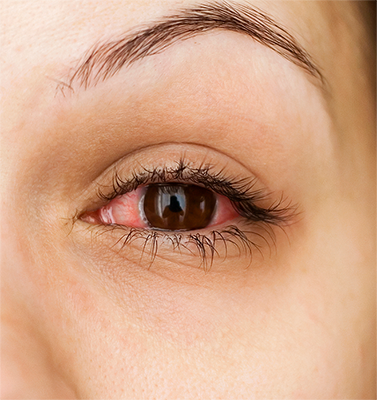Types of Ocular Allergy
An accurate medical history can help identify the offending allergens.8
Seasonal (SAC) and Perennial Allergic Conjunctivitis (PAC)
SAC is mainly related to a pollen sensitivity.2 PAC can occur in people allergic to dust mites or to multiple year-round allergens. SAC and PAC differ in when the symptoms occur and allergic sensitivity involved.2,6
SAC symptoms usually begin in childhood and can continue throughout your life, although it can decrease with age.7 Both SAC and PAC may be associated with a stuffy nose and asthma, but some people have only ocular symptoms.1,2
While SAC and PAC are not serious, they may be irritating and can affect your quality of life.2 The hallmark symptom is itchy eyes.1 You may also experience redness, tearing, mucous discharge and burning.1
Your eye care practitioner will diagnose you based on your symptoms, your family and personal history. An accurate medical history is important in identifying the offending allergens. Your eye care practitioner might order skin or blood tests to learn more about the severity and cause of your allergies.1,8
Vernal (VKC) and Atopic Keratoconjunctivitis (AKC)

Shutterstock. ID: 336490448.
VKC is a relatively rare, chronic form of ocular allergy that can cause severe inflammation and visual complications.1,6,9 It appears most often in boys.2 VKC’s chronic inflammation and acute episodes can be brought on by either exposure to the allergen or, by triggers such as wind, sunlight and dust.1,9 You may also experience intense itching, light sensitivity, a watery discharge, pain, redness, and the feeling that something is in your eye.2,6,9
AKC is a persistent condition that has been called the ocular form of eczema.6,10 AKC frequently flares up during winter months. The hallmark sign of AKC is itching of both eyelids.10 This condition may be sight-threatening.1,5
Giant Papillary Conjunctivitis (GPC)
Giant papillary conjunctivitis (GPC) is an ocular inflammatory condition usually caused by contact lens wear. It is not an “allergic reaction” to contact lenses.6 The upper eyelid of contact lens wearer can become inflamed and irritated by the contact lens edge or a reaction to deposits on the contact lens.6
Symptoms begin as mucous discharge, particularly in the morning. Most people will experience tearing, itching and redness of the eyes. As the condition progresses, you may experience a foreign body sensation and eye discomfort.2,11 These symptoms progress until wearing contact lenses becomes very uncomfortable.1







